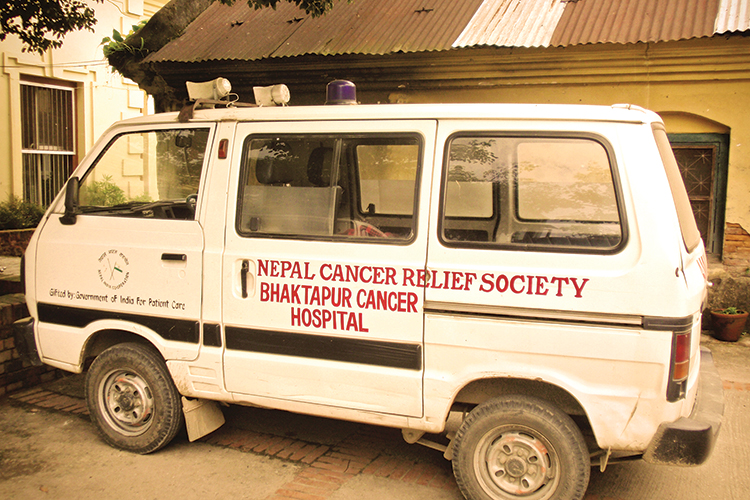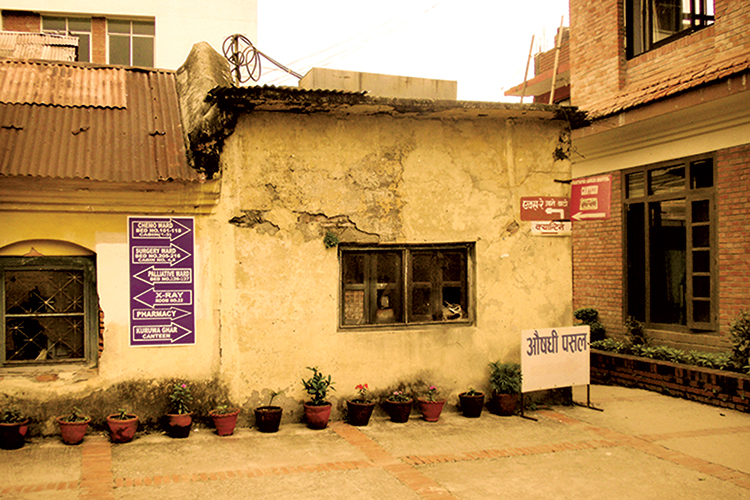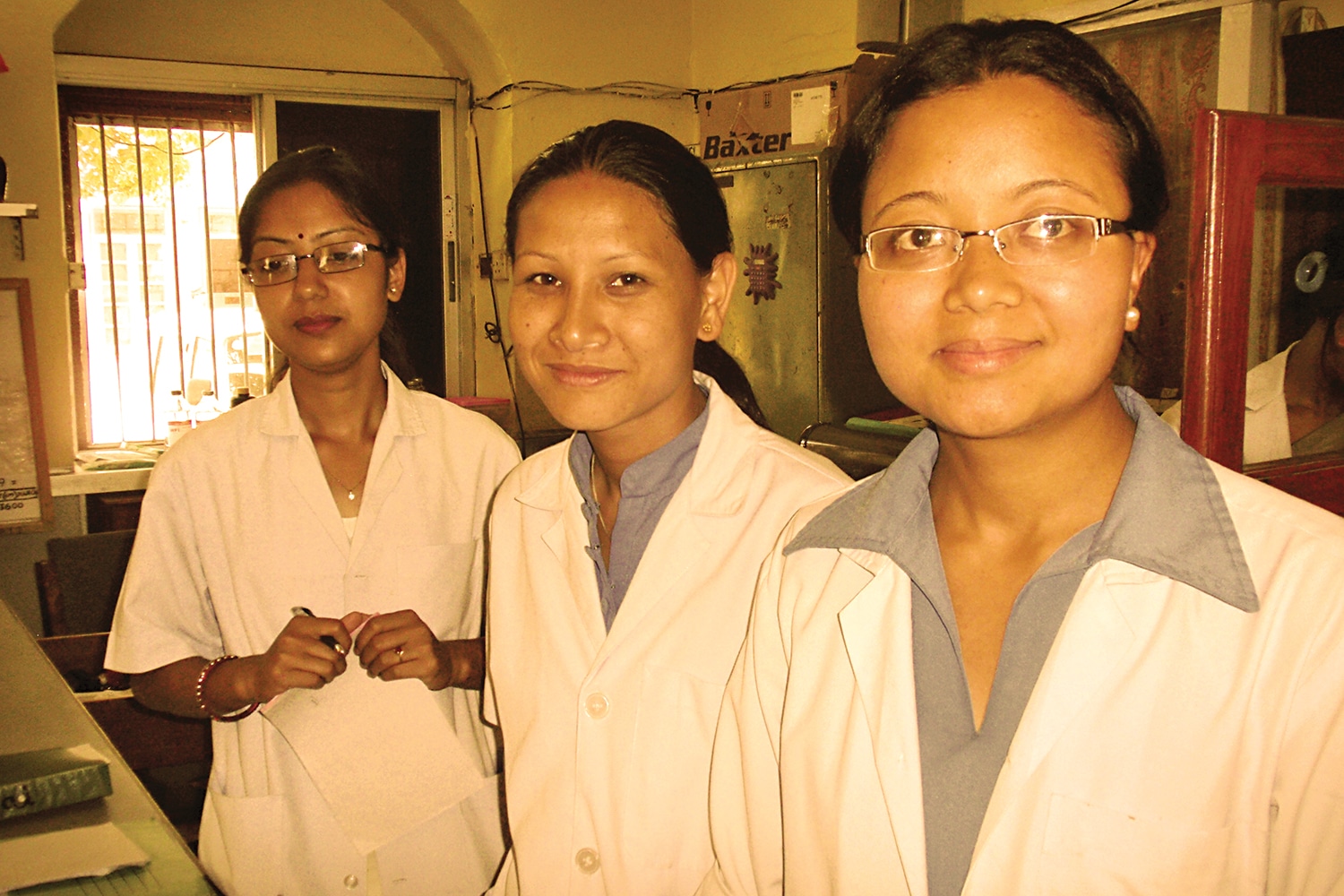Last summer, as I was walking through the streets of Bhaktapur, an ancient city on the outskirts of Kathmandu, Nepal, I found myself gazing upward. Behind intricate wood-carved window frames, men, women, children—even family dogs—peered at the people walking below. The antiquated scene reminded me yet again that I had entered a world reminiscent of an earlier time.
When I first began planning my three-week trip to the Kathmandu Valley, I knew that advances in modern cancer care had gone largely unnoticed in this impoverished nation of 29 million, nestled between India and Tibet. As an American breast cancer survivor with diagnoses in both 1993 and 2004, I’ve experienced firsthand the ways in which Western medical progress has improved the treatment of a range of cancers, including my own.
Yet Nepal lacks the means to benefit from such developments. Though it’s hard to know exactly how many Nepalis are affected by cancer, estimates suggest that some 28,000 were diagnosed with the disease in 2008, and 20,000 died of it that year.
Although I expected to find that the country’s one cancer hospital was lacking modern equipment, I was unprepared for the contrasts between the experience of having cancer in Nepal versus at home. Both the Nepalese economy and the nation’s traditions have contributed to a dramatically different perspective from my own on what it means to have cancer—from the types of healers patients seek and the level of medical services they expect, to the role of families and finances in their treatment. By the end of my visit, I had a new view on just how much our response to a cancer diagnosis depends on the culture in which we find ourselves.
Faith Healers and Family Traditions
Nepal is unusual in its wide embrace of multiple traditions. Hinduism and Buddhism are practiced side-by-side, and Nepalis seem remarkably accepting of blurred boundaries between religions. The same might be said about the acceptability of a variety of approaches to health and well-being.
Though my own cancer diagnosis spurred a longstanding habit of intense self-surveillance and frequent visits to medical specialists, the first stop for most Nepalis experiencing a nagging cough or an unusual lump is rarely a local M.D. Instead, they turn to a faith healer (Dyo-Ma, or “Goddess Mother” in the Newari language), like Mrs. Ganesh Maya Suwal, whose spiritual wisdom is believed to extend to the treatment of mental and physical problems. Or, they may seek the advice of an Ayurvedic doctor like Vaidya Mana Bajra Bajracharya, whose understanding of the “universal elements” of all life (earth, water, fire, air and ether) has been passed down from one generation to the next for more than 700 years.
Working with locals in Kathmandu who knew about my interest in the culture of health and healing in Nepal, I made plans to visit both Dyo-Ma and Bajracharya. Dyo-Ma is believed by many Nepalis to carry the spirit of Jilan Ajima, whose mother, Harati Ajima, is a goddess protecting children and mothers from harm. Through a translator, I told Dyo-Ma about my life, my diagnosis and my worries about leaving behind my young children. Eventually, I asked what she envisions for my future. Sitting on the floor of a small temple, which was designed from visions in which Harati Ajima instructed Dyo-Ma how to carry forth her work, Dyo-Ma closed her eyes and sat momentarily in silence before answering.
“Every morning, you must meditate,” she finally replied. “Have faith. All will be well if you release stress and worry, tightness in stomach. Enjoy children. Let worry go.”
Dyo-Ma‘s prediction was comfortably vague and offered no real medical insight, but I appreciated the peaceful confidence she exuded as she spoke. It was a stark contrast to the views on my condition that Bajracharya offered a week earlier, as we conversed in his simply adorned office. While a small black mouse darted along the walls and a breeze blew through a window overlooking a lush herb garden, which he uses for remedies, the Ayurvedic doctor told me that married women who bear children should not have breast cancer. Only those with “no sexual activity are very certain to have breast cancer,” Bajracharya said, “and mental problems” as well.
I was angered by the simplicity and bias of these generalizations. I was, after all, a breast cancer survivor who had developed the disease a second time after giving birth to two children. Cancer—of any type—is not so simple! I wanted to tell him. But when I replayed the visit later in my mind, I had to acknowledge a hint of science: Western doctors have reported a correlation for years between childbearing and breastfeeding and a reduced risk of breast cancer.
One thing did seem obvious to me: The words of Bajracharya as well as Dyo-Ma might provide much-needed hope to many Nepalese patients and their families in the face of cancer.
Cancer Care in Bhaktapur
When visits to faith healers and Ayurvedic practitioners fail to alleviate a patient’s symptoms, a family may take an alternate course: turning to Nepal’s version of the modern medical facility.

Photo by Cynthia Ryan
Bhaktapur Cancer Hospital is the only institution of its kind in the country, and it sits just a few miles from Durbar Square, the center of daily life in Bhaktapur, a city of 300,000 residents. Founded in 1992 by the Nepal Cancer Relief Society, the hospital opened with 15 beds; today it has 62. Vastly underfunded, it depends on the support of the Nepalese government, Rotary International and members of the local community.
On the day I toured the hospital, I asked Sujit Banskota, the hospital’s chief administrative officer, about the kinds of cancer screening the hospital offers. “We have one mammography machine, but it is not working,” he said. It wasn’t an isolated problem at the facility: New medical equipment is prohibitively expensive, and although used models are donated, they eventually break down, with no money for repairs. At present, Bhaktapur Cancer Hospital lacks among other items: a CT machine, defibrillators, a central oxygen supply system, a portable X-ray machine, and a needle destroyer for disposing of used syringes. More beds are needed to handle the increasing number of patients who come to the hospital, as are basic housekeeping items, including washing machines (hospital linens are currently washed by hand) and a scrub machine (to keep the floors clean).
As a cancer survivor, I couldn’t quite process the immense gap between the medical care that I take for granted in the U.S. and the minimal technologies available at the hospital in Bhaktapur. The contrast was evident everywhere I looked as Banskota accompanied me on my tour. We passed the chemotherapy infusion ward, where patients lay side-by-side without privacy as family members bring in meals cooked either at home or even right outside the doors of the hospital. In the palliative care unit, I observed patients lined up in beds and spoke to nurses who told me that they try to make a patient’s final days as comfortable as possible, but that resources for adequate pain management are often lacking.
As hard as it was for me to fully grasp the conditions at Bhaktapur Cancer Hospital, they reflect the economic constraints facing citizens throughout Nepal, where the average annual household income—less than $500 U.S.—is rarely sufficient to pay for food and shelter. Not surprisingly, for cancer patients and their families, the financial demands of medical care are challenging, if not impossible—with a family’s financial situation made all the more relevant by the requirement that all cancer treatments, medications and physician services be paid for in cash in advance of care.
The inability of most cancer patients to afford good treatment, even when doctors have the knowledge and the medical equipment is in operating order, has contributed to a culture in which cancer care is not as focused as it is in the U.S. on obtaining the most advanced treatment possible. Rather, cancer care often places at its center the patient’s family, which must decide how to care for their loved one without leaving the rest of the family destitute.

Nepalese families must purchase drugs at the cancer hospital’s pharmacy (above) prior to their use by patients in the hospital. Photo by Cynthia Ryan
Family Matters
A few steps from the oncology ward at Bhaktapur Cancer Hospital is a wall filled with upbeat messages of hope. Given the bleak prognosis for most Nepalese patients, the cheeriness feels incongruent. But as Blakeshari Koju, a hospital counselor, explained to me, these notes of support aren’t for patients—they’re aimed at loved ones.
One characteristic of Nepali culture is an emphasis on family. Multiple generations often dwell in the same house, and throughout their lives, they work, worship and celebrate together. As a result, I was not surprised to hear that patients and their families often respond to a cancer diagnosis in a way that prioritizes the family’s needs.
Kapendra Amatya, a surgical oncologist at Bhaktapur Cancer Hospital, told me that when a family lacks the financial resources for recommended cancer care, they may have “not only no money for treatment itself, but no money to feed the family if they attend the patient and not work.” When I asked how families determine how much they can afford for the care of a family member with cancer, Amatya admitted that “completing the treatment is a great challenge for poor patients. Some only get surgery and no radiation and chemotherapy, while others just do not complete [their] chemotherapy course.”
“Communication with the patient is minimal,” Koju added. In fact, “many Nepalis do not know the word ‘oncologist,’ so think they are just going to the doctor.” Illiteracy prevents some patients from ever realizing that they are being treated in a cancer hospital. Her own role, she added, is to communicate the patient’s condition and options to family members—usually the family’s male decision-makers.
Some patients do know the extent of their situation. Several days before visiting Bhaktapur Cancer Hospital, I had encountered a family gathered around a 78-year-old man diagnosed with cancer who was lying in a hospice located at Pashupati Temple in the Kathmandu Valley. According to the hospice attendee on duty, the man’s family lacked the money to pay for cancer treatment. As a final gesture of devotion, the man refused therapies so as not to create greater financial burdens on his family. The atmosphere among family members surrounding the man’s bed was somber, yet appreciative.
It’s been nearly a year since I returned from Nepal, but the image of this man at Pashupati Temple has stayed with me. As I go about my life, raising my daughters, heading to work and meeting with my cancer care team for routine follow-up, I think often about not just this one cancer patient and his family, but the hundreds of faces I saw peeking out from the windows lining city streets throughout the Kathmandu Valley.
I especially remember those in Durbar Square in Bhaktapur, just a short walk from the cancer hospital, and wonder how many of these individuals have had to make difficult decisions about obtaining care for a loved one diagnosed with cancer—and how much my assumptions as an American breast cancer survivor color my perspective on the magnitude of these decisions.
I left Nepal realizing that the way we take on cancer, either our own or another’s, is intricately woven into the cultural landscape we see outside our windows. It’s an admittedly partial view.
Cancer Today magazine is free to cancer patients, survivors and caregivers who live in the U.S. Subscribe here to receive four issues per year.





